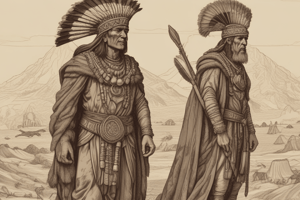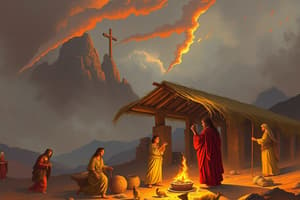Podcast
Questions and Answers
Who were the Pueblos?
Who were the Pueblos?
Native Americans that were located in Rio Grande region of the southwestern US (New Mexico, Arizona).
What were the Pueblos most known for?
What were the Pueblos most known for?
They were known for their distinct architectural style and were named after the Spanish word for town, 'pueblo'.
Who was Don Juan de Onate and why was he important?
Who was Don Juan de Onate and why was he important?
He was a conquistador from New Spain who defeated the Pueblos and helped the Spanish establish Santa Fe in 1610.
Before the Pueblo Revolt, how did the Spanish rule the Pueblos?
Before the Pueblo Revolt, how did the Spanish rule the Pueblos?
The Pueblos outnumbered the Spanish 30,000 to 2,000.
The Pueblos outnumbered the Spanish 30,000 to 2,000.
Why did the Pueblo Revolt occur?
Why did the Pueblo Revolt occur?
What happened during the Pueblo Revolt?
What happened during the Pueblo Revolt?
What was the significance of the Pueblo Revolt?
What was the significance of the Pueblo Revolt?
Study Notes
Pueblos Overview
- Pueblos are Native Americans predominantly found in the Rio Grande region of southwestern U.S., specifically in parts of New Mexico and Arizona.
- Known for their unique architectural style, the term "pueblo" is derived from the Spanish word meaning "town."
Don Juan de Onate
- A significant figure as the conquistador from New Spain, Onate was crucial in the Spanish conquest of the Pueblos.
- He played a key role in establishing Santa Fe in 1610 after defeating the Pueblo people.
Spanish Governance Over Pueblos
- Prior to the Pueblo Revolt, the Spanish imposed harsh and oppressive rule over the Pueblo peoples, limiting their cultural and religious practices.
Population Dynamics
- The Pueblo population vastly outnumbered the Spanish, with an estimated 30,000 Pueblos compared to around 2,000 Spanish colonizers.
Causes of the Pueblo Revolt
- The revolt was prompted by Spanish suppression of Native religious practices that contradicted Christianity.
- Spanish demands for tribute and labor from the Pueblos contributed to rising tensions.
Events of the Pueblo Revolt
- Led by Pope, a prominent Native leader, the revolt resulted in the deaths of hundreds of Spanish.
- Following the uprising, the Spanish were forced to retreat and did not regain control until 1696, leading to a period of over 10 years without Spanish authority.
Significance of the Pueblo Revolt
- The rebellion highlighted the Spanish attempt to religiously assimilate Native Americans.
- After the revolt, the Pueblos experienced increased freedoms and a degree of autonomy from Spanish rule.
Studying That Suits You
Use AI to generate personalized quizzes and flashcards to suit your learning preferences.
Description
Explore the rich history of the Pueblo people and their interactions with Spanish conquistadors, particularly Don Juan de Onate. This quiz delves into the architectural, cultural, and societal dynamics leading to the Pueblo Revolt. Gain insights into the impact of Spanish governance on the Pueblo communities and their response to oppression.




